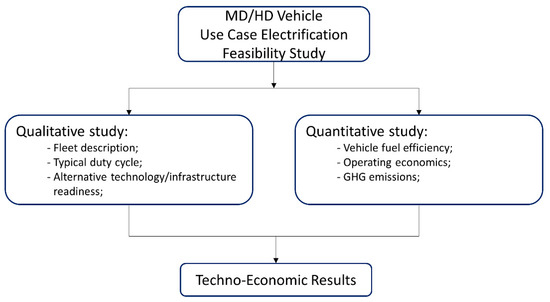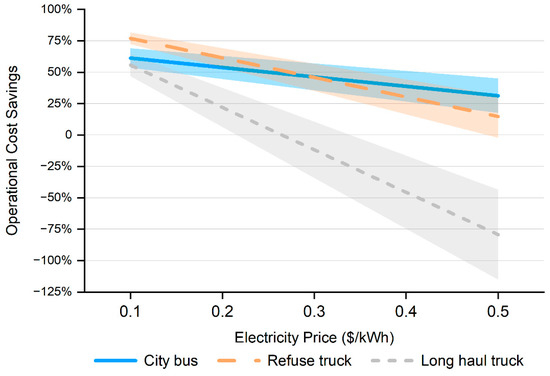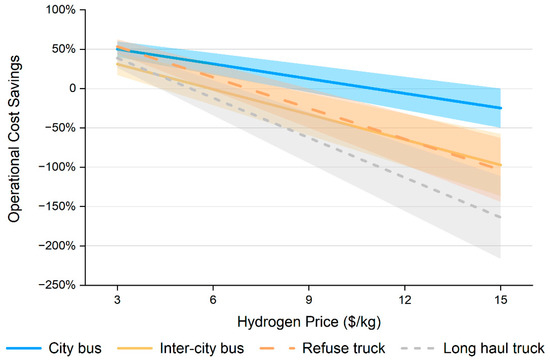Abstract
The medium- and heavy-duty (MD/HD) vehicle sector is a large emitter of greenhouse gases. It will require drastic emissions reductions to realize a net-zero carbon future. This study conducts fourteen short feasibility investigations in the Canadian context to evaluate the merits of battery electric or hydrogen fuel cell alternatives to conventional city buses, inter-city buses, school buses, courier vehicles (step vans), refuse trucks, long-haul trucks and construction vehicles. These “clean transportation alternatives” were evaluated for practicality, economics, and emission reductions in comparison to their conventional counterparts. Conclusions were drawn on which use cases would be best suited for accelerating the transformation of the MD/HD sector.
1. Introduction
In 2018, the total greenhouse gas (GHG) emissions in Canada amounted to 729 Mt, of which emissions from the transportation sector accounted for approximately a quarter. Medium- and heavy-duty (MD/HD) vehicles are used on-road to transport people and goods (buses, trucks) and off-road in, for instance, the construction, mining, agriculture and forestry sectors. Together, they cause over 40% of the total GHG emissions of the transportation sector in Canada [1]. MD/HD vehicles mainly use diesel as their fuel, causing additional emissions of Criteria Air Contaminants (CACs) that impact health. Therefore, reducing GHG emissions and CACs from the MD/HD vehicle segment could create significant social and environmental benefits.
In 2019, the Government of Canada announced its intent with a target of net-zero GHG emissions by 2050 [2]. In November 2020, the government moved forward and proposed the Canadian Net-Zero Emissions Accountability Act (Bill C-12) [3], representing the latest efforts to achieve net-zero carbon emissions by 2050. This target exceeds Canada’s previous goal for 2050, aiming at reducing the GHG emissions by 80% below 2005 levels. The new target will require a substantial to almost full decarbonization of all sectors, including transportation.
The large majority of all electricity (>80%) in Canada is generated from non-GHG emitting sources, such as hydro, nuclear, and other renewables. The electrification of transportation could therefore result in very significant GHG emission reductions, and could be a pathway towards the goal of net-zero carbon emissions.
It seems for light duty vehicles that the decarbonization path is becoming increasingly clear through electrification. Over the last decade, the sales of electric passenger vehicles in Canada have ramped up to over 2.5% of all light-duty vehicle sales by the end of 2019 [4,5,6]. Despite the impact of the COVID-19 pandemic that caused a steep drop in auto sales in the second quarter of 2020, zero-emission vehicle (ZEV) sales held a market share of 3.3% across the first half of 2020 [7]. The on-road fleet of electric passenger vehicles in Canada has been estimated to grow to over 185,000 vehicles in total (including battery and plug-in hybrid electric vehicles) by the end of 2020 [8,9].
However, the electrification of the MD/HD vehicle sector lags five to ten years behind the developments in the passenger vehicle segment. Although there has been substantial growth over the last years and the trend is anticipated to accelerate, there are currently less than 200 electrified MD/HD vehicles on the road in Canada (if not counting the ~260 electric trolley buses already running in Vancouver for well over half a century), most of them being battery electric city buses. The good news is that the electrification of the MD/HD vehicle sector is gaining momentum [10,11,12]. Market entries of battery electric and hydrogen fuel cell variants of long-haul trucks and other MD/HD vehicle models are expected to occur in the near future, as more and more traditional big automakers, such as Daimler, Volvo, Hyundai, Toyota, along with other emerging clean energy vehicle manufacturers like BYD, Tesla Inc. and Nikola Corporation, have presented significant plans for developing and manufacturing MD/HD vehicles in the coming years.
At present, urban transit buses are in the spotlight for electrification both in Canada and across the world, but for the MD/HD vehicle sector as a whole, there are still obstacles that need to be overcome. This is usually not because it is much more technically difficult, but mainly because the electrification of MD/HD vehicles is still in its nascent phase. While battery electric variants of passenger vehicles seem capable of providing the required operational characteristics for all or most passenger vehicles, there is a lack of knowledge on which clean technology (battery electric or hydrogen fuel cell) would be best suited for MD/HD vehicles. More importantly, the MD/HD vehicle sector is very diverse, with many different existing vehicle types and applications, and electrification in different use cases is not developing equally, which hinders a segment-wide approach to emission reduction. Although there have been a few studies on the technical, economic and environmental evaluations of the electrification of MD/HD vehicles [13,14,15,16,17], dedicated studies in different MD/HD vehicle use cases are scarce and hardly available in published information. Therefore, this study is one of the first efforts within the MD/HD segment in Canada aiming at providing a detailed evaluation of emission reduction options per use case, in order to help selected MD/HD vehicle types to bridge that gap.
2. Methodology
As electrification of the MD/HD vehicle sector is in its early stages in Canada, many key details are not readily attainable. This study therefore applied a mixed methods approach, as described in [18,19], which integrated qualitative and quantitative methods, to help better understand the problem. A simplified flow chart of the approach is given in Figure 1.

Figure 1.
Flow chart of the research approach.
Fourteen short, high-level feasibility studies were conducted to evaluate the practicality, economics and emission reduction potential of battery electric and hydrogen fuel cell alternatives of eight types of conventional diesel MD/HD vehicles. The techno-economic analysis results of these fourteen studies are presented in this article.
Details on the vehicles and the approximate sizes of their fleets are given in Table 1. Excavators are the most common type of off-road construction equipment. However, there are no data on their fleet size. Table 2 presents the specific clean transportation variants evaluated, and indicates the approximate stage of development for each use case. For school buses and courier vehicles, the battery electric option is the preferred option, and therefore, the hydrogen fuel cell route was not investigated.

Table 1.
MD/HD vehicles evaluated and estimated fleet sizes in Canada.

Table 2.
Vehicle use cases and clean technologies evaluated (marked as “X”), with stage of development.
A clean transportation alternative is deemed practical when the vehicle can be used in the same way as the conventional diesel variant with no or only minor adjustments to its operation. At the current technology level, battery electric vehicles are generally cheaper to purchase and operate than hydrogen fuel cell vehicles, and therefore battery electric vehicles are preferred from an economic point of view if they can meet the requirements. The assessment included both the driving and the recharging or refueling of the vehicle, to ensure it will be ready for its next working period.
The economic evaluation of the battery electric and hydrogen fuel cell vehicles focused on determining the potential savings in annual operational costs (for fuel and maintenance) in comparison to conventional diesel variants. Unfortunately, it was impossible to expand this economic evaluation to include the calculation of a realistic payback time for these vehicles, because many vehicles are still at the stage of concept, prototype or first pilot. For these vehicles, either no information was available on their purchase price, or their price was very high due to low-volume production, and was not realistic for future large-scale deployment, nor suitable for comparison to the price of mass-produced diesel vehicles.
Different electricity prices were determined for vehicles using different power levels for their recharging. In general, the electricity costs for recharging increase with the level of charge power, because of the higher costs of the charging stations. Table 3 presents the purchase and installation costs for three typical levels of charge power, based upon [28]. Depending on the level of charge power, the costs of the on-site charging infrastructure will add $0.05 to $0.10 (all the dollars in this article are Canadian dollars unless indicated otherwise) on top of the electricity price.

Table 3.
Investments costs for electric vehicle chargers and calculated capital costs per kWh of recharging.
Electricity prices vary significantly between the different provinces in Canada. A typical overnight electricity rate of $0.15/kWh was used for overnight recharging. This rate includes demand charges. Table 4 displays the overall electricity prices (electricity rate plus infrastructure costs) that were used in the feasibility studies. Based on the results from Table 3, we used capital cost contributions to the overall electricity price of $0.05/kWh for Level 2 charging and $0.10/kWh for Level 3 charging. A Megawatt charger may be required to quickly recharge electric long-haul trucks during the day. As this type of recharger is not available on the market yet, an estimate of costs per kWh was made based upon the costs of lower-power chargers, using a $0.20/kWh daytime electricity rate and $0.30/kWh for capital costs, for a total of $0.50/kWh.

Table 4.
Fuel costs and electricity costs.
For each vehicle type, the appropriate level of charge power was determined based upon daily driving distance, the specific electricity consumption per km, and the amount of time available for recharging.
Given the goal to almost completely reduce GHG emissions, hydrogen has been suggested for production through electrolysis using clean electricity. The price for hydrogen reflects the current cost level. A sensitivity study into the impact of future lower hydrogen prices on the results for on-road MD/HD vehicles is included at the end of this paper. A similar analysis was done to investigate the effect of different recharge prices on the economic results for battery electric buses and trucks. It is expected that over time the costs of charging infrastructure will decrease due to technological advancements and deployment at a large scale.
GHG emissions were evaluated using a value of 2.7 kg CO2eq/L for diesel, an average electricity emission intensity for Canada of 0.15 kg CO2eq/kWh, and associated emissions of 7.9 kg CO2eq/kg of hydrogen using this electricity.
3. Results of Short Feasibility Studies
3.1. Perspective on the Results
When bringing together scarce information on many different MD/HD use cases, and evaluating clean transportation alternatives that are in quite different stages of development, it is inevitable that the data set used will vary significantly in the level of detail, and will span the full range from real-world operational measurements to assumed performance values. The results of the fourteen short feasibility studies should therefore be regarded as an indication of use cases that are more or less favorable for electrification, rather than a fully consistent set of precise numerical results.
3.2. Buses
City buses are at the forefront of MD/HD electrification, with pilot electric bus projects underway or planned in many Canadian cities [29,30,31,32]. Various recharging methods for electric city buses (overnight, end-of-route, mid-route) are being investigated. Electric city buses seem close to being able to fulfil the same driving demands as most diesel buses, as several transit authorities have announced plans to stop buying diesel buses by the middle of this decade [33,34,35]. On the contrary, the electric inter-city bus is still in a very early development stage, with only a couple of pilot-scale demonstration projects carried out in Canada and the US so far [36].
In this study, an electric city bus with a representative annual driving distance of 60,000 km [37] and with overnight recharging at 50 kW was evaluated. The electric city bus needed 1.2 kWh/km driven [33,38], compared to 64 L/100km for a diesel city bus [39]. Maintenance costs of electric buses were 40% lower than those of diesel buses [38].
Inter-city buses typically drive over large stretches of highway. They are designed similarly to city buses, but typically have extra space for luggage storage. The annual average driving distance is about 40,000 km [20]. This study focused on the inter-city buses that are operated for day trips only so that the electric bus could be charged with a low-cost Level 2 charger at the place where the vehicle is parked during the night. Performance data for diesel and electric inter-city buses are obtained from [36,40]. Similar to electric city buses, the maintenance costs of electric inter-city buses were 40% lower than those of diesel buses.
Hydrogen fuel cell city and inter-city buses are in their infancy, either in prototype development or only in the conceptual stage. It was assumed that city buses consume 10 kg of hydrogen per 100 km [41,42]. The data on hydrogen consumption for inter-city buses was not available, and it was estimated based upon the ratio between the performance values of battery electric and hydrogen city buses. It was also assumed that both hydrogen bus types had the same maintenance costs as their battery electric alternatives.
School buses generally drive about 100 km per day of operation [21,43], which is substantially less than city buses and inter-city buses, and are parked for much longer periods overnight. This will allow electric school buses to use Level 2 recharging as well, instead of the more expensive fast charging needed by city buses. Similar to electric city buses, electric school buses were assumed to need 40% less maintenance than diesel school buses.
The results of the economic evaluation (see Table 5) indicate that battery electric city buses, inter-city buses and school buses can provide significant reductions in annual operating costs, benefiting from large savings on both fuel costs and maintenance costs. These outcomes seem promising to potentially enable lower total cost of ownership values in the future.

Table 5.
Annual results (if not specified differently) for diesel, battery electric and hydrogen fuel cell buses (per vehicle).
The recommended battery size and charge power are suggested based upon daily driving distance of the vehicles and the available recharging period by considering the typical duty cycles of each type of vehicle. The recommended battery sizes are in line with current market offerings, e.g., [44]. The recommended charge power is also provided by considering the principle of keeping the operational costs as low as possible.
It should be noted that the charging efficiency is an important factor that needs to be considered in the electricity consumption and cost calculation. However, there is no indication in the references we use for the performance characteristics of electric buses and trucks that explicitly explains whether or not the charging efficiency has been included in these performance values. Therefore, in our calculation, it is assumed that all the electric vehicle performance data (kWh/km or kWh/hr) are related to the amount of AC grid power, similarly to the standard reporting method for passenger vehicles.
Hydrogen fuel cell city and inter-city buses do not create operational cost savings at the current price of hydrogen.
Battery electric city buses, inter-city buses and school buses drastically reduce emissions compared to their diesel variants. Hydrogen fuel cell city buses can also reduce emissions considerably; however, hydrogen fuel cell inter-city buses only indicate marginal emission reductions, because of their inherent higher fuel efficiency and lower mileage compared to city buses.
3.3. Trucks
There is great momentum in the development of electrified trucks, with for instance Tesla [45] and Nikola [46] being close to delivering commercial products in the long-haul category. Several large courier companies are experimenting with electrified step vans [47,48,49,50,51,52], and pilots are being conducted with electrified refuse trucks [53,54,55]. With very limited on-road results available, it was not possible to carry out a detailed evaluation of the practicality of these clean transportation use cases. Instead, a high-level assessment was made.
Courier vehicles (step vans) generally have fixed or predetermined routes and predictable operating schedules with return-to-base operation. Their average daily distance of close to 100 km [43] and long overnight parking period make low-cost Level 2 recharging possible. The maintenance costs of electric step vans were estimated to be 60% of those of similar diesel vehicles [56,57]. Vehicle performance numbers for diesel and electric variants were taken from [58,59], respectively.
Refuse trucks collecting garbage in urban areas drive 50–200 km/day [55,60], with up to 1000 stops [61]. This mode of operation results in a low vehicle efficiency (83 L/100 km) and significant maintenance costs, among the worst across the HD vehicle category [39]. Electrified refuse trucks have the potential for improved vehicle performance and reduced maintenance costs through the application of regenerative braking. Performance values for the electric refuse truck were based on [55], while performance characteristics for hydrogen fuel cell refuse trucks were not available and were estimated by applying the same methodology used for determining the performance of hydrogen inter-city buses.
Diesel long-haul trucks on average consume 39 L/100 km [39] and drive 150,000 km/year [62,63]. Performance data for battery electric and hydrogen fuel cell long-haul trucks were scarce and had to be estimated, as the “average” performance values presented in Table 6 [64,65,66]. Electrified long-haul trucks are expected to have only half of the maintenance costs of diesel trucks [63]. The recommended battery size and charge power for the trucks and vans are also presented. Although the large battery pack of a battery electric long-haul truck will reduce its payload capacity, this was not seen as a show-stopper for this application, as there are many companies transporting goods that are volume-constrained rather than weight-constrained. The first offerings of electric long-haul trucks (like the Tesla Semi) will not have the range to complete a full day of driving. In the analysis, this truck was assumed to do 60% of its charging overnight at its home base, while picking up another 40% at a Megawatt charger at some time during the day. This resulted in an average recharge price of $0.35 per kWh.

Table 6.
Annual results (if not specified differently) for diesel, battery electric and hydrogen fuel cell trucks (per vehicle).
Significant reductions in operational costs were predicted for the step van and the refuse truck (see Table 6). Long-haul trucks on diesel still had the lowest operational costs, mainly due to the high price for ultra-fast charging and hydrogen.
All electrified vehicles achieved substantial to drastic emission reductions.
3.4. Construction Vehicles
The electrification of construction vehicles is beneficial to vehicle operators and construction site workers by reducing air contaminants and noises in operating. The potential for regenerative charging with braking and boom/bucket movements is also important for some vehicle types.
There are many types and sizes of construction vehicles, such as compact rollers, dump trucks, backhoe loaders, motor graders, bulldozers, and excavators. Excavators are the most abundant type of construction vehicle. A small excavator (based upon the CAT 304E3 CR model [67]) and a large excavator (based upon a CAT 390F L [67]) were therefore taken as examples for the evaluation of the electrification potential of construction vehicles.
For each type of excavator, the characteristics of the battery electric and hydrogen fuel cell alternatives were determined based upon assumed energy conversion efficiencies. Given the highly intermittent mode of operation of excavators, a 20% efficiency was used for the diesel engine, an 80% efficiency for the battery electric excavator, and 40% for the hydrogen fuel cell one. Electrified excavators were assumed to have 20% lower maintenance costs than diesel excavators.
Construction vehicles need to be refuelled on-site, regardless of the type of fuel used. This creates additional challenges for providing electric power and hydrogen to a remote and/or ever-changing jobsite. As it is unclear how this will be done in the future, it is not possible to calculate an actual recharging/refueling rate, and a rough estimate of the overall recharge/refueling rate was used in this study.
Table 7 presents the results for annual operational cost savings and GHG emissions reductions for the battery electric and hydrogen fuel cell alternatives.

Table 7.
Annual results (if not specified differently) for diesel, electric and hydrogen fuel cell excavator variants (per vehicle).
On-site recharging/refueling associated higher costs for electrified versions. Consequently, only the small battery electric excavator had significant operational cost savings.
3.5. Sensitivity for the Price of Electricity and for Hydrogen
The fuel price at the pump is the dominant factor that affects the operational costs of the vehicle; therefore, a sensitivity analysis was conducted on the selected on-road ZEV models discussed in this study based on various estimated electricity and hydrogen prices.
Figure 2 illustrates how a change in electricity prices would affect the operational cost savings for battery electric city buses, refuse trucks and long-haul trucks. School buses, inter-city buses and step vans were not included in this analysis because these buses and vans can take advantage of low-cost, slower chargers. Positive numbers in the figure show that there are operational cost savings at the given price, while negative numbers mean that there are no savings (the cost is actually increased). City buses and refuse trucks show substantial positive savings at the electricity price range between $0.1 and $0.5/kWh, whereas long-haul trucks do not present any savings until the electricity price reduces to about $0.26/kWh.

Figure 2.
Impact of electricity price on the operational cost savings of MD/HD battery electric vehicles in comparison to diesel versions of these vehicles.
The price of hydrogen is expected to decrease over the next decade(s) through both technology development and an increase in the scale of production. IEA and other institutes, for instance, indicate a future price in the range of $1–$5 per kg for the large-scale, on-site production of hydrogen [68,69,70]. Additionally, a further development of low-cost renewable power generation may reduce electricity costs and consequently hydrogen production costs.
Figure 3 displays the impact a lower hydrogen price would have on the operational cost savings for hydrogen fuel cell city buses, inter-city buses, refuse trucks and long-haul trucks. While city buses can produce positive operational savings at a price of $11 per kg of hydrogen, the other three types of vehicles start to show savings only at much lower hydrogen prices ranging from about $5 to $7 per kg.

Figure 3.
Impact of hydrogen price on operational cost savings of MD/HD fuel cell vehicles in comparison to the diesel versions of these vehicles.
It should be noted that the results of Figure 2 and Figure 3 should be used with extreme care because there still is considerable uncertainty concerning the actual fuel consumption rates of those vehicles, especially in Canada’s cold climate. The color shaded bands presented in Figure 2 and Figure 3 reflect the impact of a 20% reduction or improvement in vehicles performance, i.e., fuel consumptions and maintenance costs, on the operational cost savings.
4. Conclusions
The results of the high-level evaluation of fourteen battery electric or hydrogen fuel cell alternatives to conventional diesel MD/HD vehicles broadly indicate a greater potential for operational cost savings and drastic emissions reductions for battery electric vehicles than for hydrogen fuel cell vehicles.
All fuel cell vehicles have higher operating costs than diesel vehicles at the current relatively high price of hydrogen. Lower hydrogen costs in the future could potentially enable operational cost savings for these vehicles. The hydrogen city bus, in comparison to the inter-city bus, the refuse truck and the long-haul truck, would be the first vehicle type to break even once low-cost hydrogen can be supplied.
Battery electric city buses, inter-city buses and school buses save 30% to 50% on fuel and maintenance costs, providing good prospects for the lower total cost of ownership in the future. The GHG emissions reductions for these vehicles are in the range of 77% to 90%.
The high cost of (ultra-)fast charging is a disadvantage for the larger MD/HD vehicles with intense duty cycles. For example, a battery electric long-haul truck would not achieve operational cost savings until it can be charged at about $0.26 per kWh. The electrification of smaller vehicles (step vans) or of school buses, inter-city buses and refuse trucks (having lower daily distances and longer parking periods) is favored, because they can benefit from cheaper recharging options.
The requirement of on-site charging for off-road construction vehicles at the actual construction site is a major challenge for the electrification of this sector. Although both small and large battery electric excavators present 86% GHG emissions reductions, only the small type offers substantial operational cost savings (25%).
The results of this study should be seen as a first indication of the potential to electrify MD/HD vehicles, rather than a fully consistent set of precise numerical results, because performance information for some vehicles was not publicly obtainable and the study had to rely on assumed values. The analysis considers the electrification potential of individual vehicles for specific charging stations’ power levels, some of which have not yet been deployed (e.g., 1 MW is not yet available on the market). The results might be impacted by considering the system level impact at the fleet level (e.g., sharing charging stations across multiple vehicles), as well as the uncertainties including installation and electricity costs. A follow-up study is recommended to address these aspects, as well as to include vehicle manufacturing costs in addition to the operating costs.
Author Contributions
Conceptualization and project administration, H.R.; formal analysis and investigation, H.R., Y.W., K.L. and L.Y.; writing—original draft preparation, H.R.; writing—review and editing, H.R., Y.W., K.L. and L.Y. All authors have read and agreed to the published version of the manuscript and accepted responsibility for the overall integrity of the paper.
Funding
Funding for this work was provided by Natural Resources Canada through the Program of Energy Research and Development.
Conflicts of Interest
The authors declare no conflict of interest, and the funder had no role in the writing of the manuscript, or in the decision to publish the results.
References
- Environment and Climate Change Canada. National Inventory Report 1990–2018: Greenhouse Gas Sources and Sinks in Canada. Available online: http://www.publications.gc.ca/site/eng/9.506002/publication.html (accessed on 30 April 2020).
- Governor General. Moving Forward Together: Speech from the Throne to Open the First Session of the Forty-Third Parliamentof Canada. Available online: https://www.canada.ca/en/privy-council/campaigns/speech-throne/moving-forward-together.html (accessed on 5 December 2019).
- House of Commons of Canada. An Act Respecting Transparency and Accountability in Canada’s Efforts to Achieve Net-Zero Greenhouse Gas Emissions by the Year 2050 (Bill C-12). Available online: https://parl.ca/DocumentViewer/en/43-2/bill/C-12/first-reading (accessed on 19 November 2020).
- Klippenstein, M. Canada EV Sales. Available online: http://tinyurl.com/CanadaEVSales (accessed on 26 February 2020).
- Statistics Canada. New Motor Vehicle Registrations. 2019. Available online: https://www150.statcan.gc.ca/n1/daily-quotidien/200724/dq200724b-eng.htm (accessed on 20 October 2020).
- Statistics Canada. More Vehicles on the Road in 2019. Available online: https://www150.statcan.gc.ca/n1/daily-quotidien/200910/dq200910d-eng.htm?indid=635-1&indgeo=0 (accessed on 20 October 2020).
- Sarabia, L. Electric Vehicle Sales in Canada Fell Sharply in Q2 2020, at Height of COVID-19 Lockdown. Available online: https://electricautonomy.ca/2020/08/26/canadian-ev-sales-data-q2-2020/ (accessed on 20 October 2020).
- Statistics Canada. Automotive Statistics. Available online: https://www.statcan.gc.ca/eng/topics-start/automotive (accessed on 1 February 2021).
- Sarabia, L. New Canadian EV Sales Figures from Statistics Canada Show Strong Recovery in Q3 2020, Following Sharp Lockdown Dip. Available online: https://electricautonomy.ca/2021/02/11/canadian-ev-sales-data-q3-2020/ (accessed on 15 February 2021).
- Eurelectric. Electrification of Heavy Duty Vehicles A Eurelectric Statement; Eurelectric: Brussels, Belgium, 2017. [Google Scholar]
- Roberts, D. Big Electric Trucks and Buses Are Coming. Here’s How to Speed Up the Transition. Available online: https://www.vox.com/energy-and-environment/2020/11/19/21571042/tesla-electric-cars-trucks-buses-daimler-volvo-vw-charging (accessed on 1 February 2021).
- Geotab. Medium and Heavy-Duty Electrification Trends. Available online: https://www.geotab.com/white-paper/heavy-duty-fleet-electrification-trends/ (accessed on 1 February 2021).
- Mol, C.; O’Keefe, M.; Brouwer, A.; Suomela, J. Trends and insight in heavy-duty vehicle electrification. World Electr. Veh. J. 2010, 4, 307–318. [Google Scholar] [CrossRef]
- Smith, D.; Graves, R.; Ozpineci, B.; Jones, P.T.; Lustbader, J.; Kelly, K.; Walkowicz, K.; Birky, A.; Payne, G.; Sigler, C.; et al. Medium- and Heavy-Duty Vehicle Electrification An Assessment of Technology and Knowledge Gaps; Oak Ridge National Laboratory, National Renewable Energy Laboratory: Oak Ridge, TN, USA, 2019. [Google Scholar]
- Vijayagopal, R.; Rousseau, A. Benefits of Electrified Powertrains in Medium- and Heavy-Duty Vehicles. World Electr. Veh. J. 2020, 11, 12. [Google Scholar] [CrossRef]
- Gopinathan, N. Electrification of Non-Road and Heavy-Duty Vehicles; University of British Columbia: Vancouver, BC, Canada, 2020. [Google Scholar]
- Automotive World. Medium- and Heavy-Duty Truck Electrification. Available online: https://www.automotiveworld.com/special-reports/medium-and-heavy-duty-truck-electrification/ (accessed on 1 February 2021).
- Molina-Azorin, J.F. Mixed Methods Research in Strategic Management:Impact and Applications. Organ. Res. Methods 2012, 15, 33–56. [Google Scholar] [CrossRef]
- Borowski, P.F. New Technologies and Innovative Solutions in the Development Strategies of Energy Enterprises. HighTech Innov. J. 2020, 1, 39–58. [Google Scholar] [CrossRef]
- Natural Resource Canada. National Energy Use Database. Available online: http://oee.nrcan.gc.ca/corporate/statistics/neud/dpa/menus/trends/comprehensive_tables/list.cfm (accessed on 6 March 2020).
- Schoolbus Fleet. 2019 Canadian Fact Book. Available online: http://digital.schoolbusfleet.com/CanFact2019#&pageSet=0 (accessed on 28 February 2020).
- Statistics Canada. Passenger Bus and Urban Transit. Available online: https://www150.statcan.gc.ca/t1/tbl1/en/tv.action?pid=2310008601 (accessed on 28 February 2020).
- Purolator Inc. Purolator Facts & History. Available online: https://www.purolator.com/en/purolator-facts-history (accessed on 28 February 2020).
- United Parcel Service of America, Inc. UPS Canada Fact Sheet. Available online: https://www.ups.com/ca/en/about/facts/canada.page (accessed on 28 February 2020).
- FedEx Corporation. FedEx Express Canada Quick Facts. Available online: https://www.fedex.com/en-ca/about.html#1 (accessed on 28 February 2020).
- Kilcarr, S. Maintenance Saves Money. Available online: https://www.waste360.com/mag/waste_maintenance_saves_money (accessed on 11 September 2019).
- KRTS Transportation Specialists Inc. Industry Facts. Available online: https://www.krway.com/about/industry-facts/ (accessed on 6 June 2019).
- Nicholas, M. Estimating Electric Vehicle Charging Infrastructure Costs Across Major U.S. Metropolitan Areas; International Council on Clean Transportation: Washington DC, USA, 2019. [Google Scholar]
- Clean Energy Canada. Will Canada Miss the Bus? Simon Fraser University: Vancouver, BC, Canada, 2019. [Google Scholar]
- Ryan, S. Global News. Edmonton to Boast Canada’s Largest Fleet of Electric Buses. Available online: https://globalnews.ca/news/5136476/edmonton-electric-bus-fleet/ (accessed on 31 May 2019).
- Stevenson, J. Toronto Gets Its First Electric TTC Bus. Available online: https://torontosun.com/news/local-news/toronto-gets-its-first-electric-ttc-bus (accessed on 31 May 2019).
- Holliday, I. CTV News. Battery-Powered Electric Buses Enter Service in Metro Vancouver. Available online: https://bc.ctvnews.ca/battery-powered-electric-buses-enter-service-in-metro-vancouver-1.4589373 (accessed on 16 September 2019).
- PluginCanada. Progress and Policies in Canadian Cities. Available online: https://www.plugincanada.ca/e-bus-background/ (accessed on 14 June 2019).
- Neufeld, L. CBC News. Edmonton Plans to Buy Only Electric Transit Buses Beginning in 2020. Available online: https://www.cbc.ca/news/canada/edmonton/edmonton-transit-bus-electric-diesel-robar-1.4276453 (accessed on 17 June 2019).
- Szymkowski, S. Green Car Reports. These 12 Cities Will Buy Only Electric Buses from 2025 on; More Expected to Join. Available online: https://www.greencarreports.com/news/1113794_these-12-cities-will-buy-only-electric-buses-from-2025-on-more-expected-to-join (accessed on 2 August 2019).
- Sustainable-Bus. Canada, Coach Atlantic Maritime Bus to Introduce Electric Coach by 2022. A Test with MCI. Available online: https://www.sustainable-bus.com/coach/canada-coach-atlantic-maritime-bus-to-introduce-electric-coach-by-2022-a-test-with-mci/ (accessed on 20 October 2020).
- OC Transpo. OC Transpo Statistics. Available online: https://www.octranspo.com/en/about-us/stats/ (accessed on 14 June 2019).
- Aber, J. Electric Bus Analysis for New York City Transit; Columbia University: New York, NY, USA, 2016. [Google Scholar]
- Alternative Fuels Data Center; Energy Efficiency & Renewable Energy; U.S. Department of Energy. Average Fuel Economy of Major Vehicle Categories. Available online: https://afdc.energy.gov/data/10310 (accessed on 14 June 2019).
- Cai, H.; Burnham, A.; Wang, M.; Hang, W.; Vyas, A. The GREET Model Expansion for Well-to-Wheels Analysis of Heavy-Duty Vehicles; Argonne National Laboratory: Chicago, IL, USA, 2015. [Google Scholar]
- Eudy, L.; Post, M. BC Transit Fuel Cell Bus Project Evaluation Results: Second Report; National Renewable Energy Laboratory: Golden, CO, USA, 2014. [Google Scholar]
- Hydrogen Europe. Hydrogen Buses. Available online: https://www.hydrogeneurope.eu/hydrogen-buses (accessed on 9 October 2019).
- Alternative Fuels Data Center; Energy Efficiency & Renewable Energy; U.S. Department of Energy. Maps and Data, Average Annual Vehicle Miles Travelled by Major Vehicle Categories. Available online: https://afdc.energy.gov/data/ (accessed on 28 February 2020).
- Electric Bus Feasibility Study for the City of Edmonton; MARCON: Montreal, QC, Canada, 2016.
- Tesla. Available online: https://www.tesla.com/en_CA/semi (accessed on 18 July 2019).
- Nikola Motor. Available online: https://nikolamotor.com/motor (accessed on 18 July 2019).
- Purolator Inc. 2009 Annual Review. Available online: https://stg10.purolator.com/assets/pdf/news-room/Purolator_AR09_E.pdf (accessed on 9 March 2020).
- Today’s Trucking. The Green Mile: Purolator Unveils First Fully Electric Truck. Available online: https://www.todaystrucking.com/the-green-mile-purolator-unveils-first-fully-electric-truck/ (accessed on 9 March 2020).
- United Parcel Service of America, Inc. Environmental Responsibility. Available online: https://sustainability.ups.com/fuels-and-fleets/ (accessed on 9 March 2020).
- UPS Pressroom. UPS to Test New Electric Vehicle. Available online: https://www.pressroom.ups.com/pressroom/ContentDetailsViewer.page?ConceptType=PressReleases&id=1532964104882-384 (accessed on 9 March 2020).
- FedEx Corporation. 2018 Global Citizenship Report. Available online: https://about.van.fedex.com/newsroom/fedex-releases-2018-global-citizenship-report/ (accessed on 9 March 2020).
- Formisano, J. FedEx Blog. A Look at the Modec Lithium-Ion FedEx Express Delivery Vehicle. Available online: https://about.van.fedex.com/blog/a-look-at-the-modec-lithium-ion-fedex-express-delivery-vehicle/ (accessed on 9 March 2020).
- Kane, M. Volvo Delivered First Electric Trucks to Customers in Sweden. Available online: https://insideevs.com/news/342921/volvo-delivered-first-electric-trucks-to-customers-in-sweden/ (accessed on 6 August 2019).
- Dzikiy, P. Mack Trucks Debuts Electric Garbage Truck, Will Test on NYC Streets Next Year. Available online: https://electrek.co/2019/05/08/mack-electric-garbage-truck/ (accessed on 2 August 2019).
- Gitlin, J.M. Seattle Makes History with Electric Garbage Truck. Available online: https://arstechnica.com/cars/2019/05/seattle-makes-history-with-electric-garbage-truck/ (accessed on 6 August 2019).
- Gallo, J.B.; Tomić, J. Battery Electric Parcel Delivery Truck Testing and Demonstration; California Hybrid, Efficient and Advanced Truck Research Center: Pasadena, CA, USA, 2013. [Google Scholar]
- FleetAnswers. Vehicle Trends & Maintenance Costs Survey. Available online: http://www.fleetanswers.com/content/vehicle-trends-maintenance-costs-survey-report (accessed on 28 February 2020).
- Federal Highway Administration. Highway Statistics 2016, Table VM-1. Available online: http://www.fhwa.dot.gov/policyinformation/statistics/2016/ (accessed on 2 February 2020).
- Pelletier, S.; Jabali, O.; Laporte, G. Battery Electric Vehicles for Goods Distribution: A Survey of Vehicle Technology, Market Penetration, Incentives and Practices; Interuniversity Research Centre on Enterprise Networks, Logistics and Transportation: Montreal, QC, Canada, 2014. [Google Scholar]
- Evarts, E.C. Mack Plans to Send Electric Trucks to the Garbage Dump. Available online: https://www.greencarreports.com/news/1123352_mack-plans-to-send-electric-trucks-to-the-garbage-dump (accessed on 11 September 2019).
- Transport Topics. Lion, BEV Launch Electric Refuse Truck. Available online: https://www.ttnews.com/articles/lion-bev-launch-electric-refuse-truck (accessed on 6 August 2019).
- Hooper, A.; Murray, D. An Analysis of the Operational Costs of Trucking: 2018 Update; American Transportation Research Institute: Arlington, VA, USA, 2018. [Google Scholar]
- Earl, T.; Mathieu, L.; Cornelis, S.; Kenny, S.; Ambel, C.C.; Nix, J. Analysis of long haul battery electric trucks in EU-Marketplace and technology, economic, environmental, and policy perspectives. In Proceedings of the 8th Commercial Vehicle Workshop, Graz, Austria, 17–18 May 2018. [Google Scholar]
- Zhao, H.; Wang, Q.; Fulton, L.; Jaller, M.; Burke, A. A Comparison of Zero-Emission Highway Trucking Technologies; The University of California Institute of Transportation Studies: Davis, CA, USA, 2018. [Google Scholar]
- Sharpe, B. Zero-Emission Tractor-Trailers in Canada; International Council on Clean Transportation: Washington DC, USA, 2019. [Google Scholar]
- Wiginton, L.; Smith, C.; Ewing, M.; Battista, G. Fuel Savings and Emissions Reductions in Heavy-Duty Trucking a Blueprint for Further Action in Canada; Pembina Institute: Calgary, AB, Canada, 2019. [Google Scholar]
- Caterpillar. Caterpillar Performance Handbook; Caterpillar: Peoria, IL, USA, 2018. [Google Scholar]
- ZEN Clean Energy Solutions. British Columbia Hydrogen Study; ZEN and the Art of Clean Energy Solutions: Vancouver, BC, Canada, 2019. [Google Scholar]
- Bloomberg. Hydrogen’s Plunging Price Boosts Role as Climate Solution. Available online: https://www.bloomberg.com/news/articles/2019-08-21/cost-of-hydrogen-from-renewables-to-plummet-next-decade-bnef (accessed on 9 March 2020).
- The Future of Hydrogen; International Energy Agency: Paris, France, 2019.
Short Biography of Authors
 |
|
 |
|
 |
|
 |
|
Publisher’s Note: MDPI stays neutral with regard to jurisdictional claims in published maps and institutional affiliations. |
© 2021 by the authors. Licensee MDPI, Basel, Switzerland. This article is an open access article distributed under the terms and conditions of the Creative Commons Attribution (CC BY) license (https://creativecommons.org/licenses/by/4.0/).